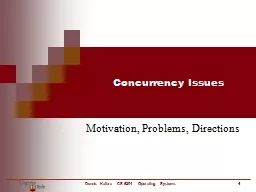PPT-Concurrency (2)
Author : giovanna-bartolotta | Published Date : 2017-06-17
CSE 132 Question The following four numbers are in 8bit 2s complement form 00000000 10101010 01010101 11111111 Which order below represents lowest to highest A 00000000
Presentation Embed Code
Download Presentation
Download Presentation The PPT/PDF document "Concurrency (2)" is the property of its rightful owner. Permission is granted to download and print the materials on this website for personal, non-commercial use only, and to display it on your personal computer provided you do not modify the materials and that you retain all copyright notices contained in the materials. By downloading content from our website, you accept the terms of this agreement.
Concurrency (2): Transcript
Download Rules Of Document
"Concurrency (2)"The content belongs to its owner. You may download and print it for personal use, without modification, and keep all copyright notices. By downloading, you agree to these terms.
Related Documents














